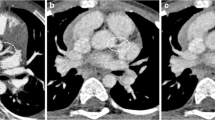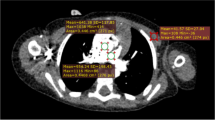Abstract
Background
Multidetector CT (MDCT) seems to be a promising tool for detection of neonatal coronary arteries, but whether the ECG-gated or non-ECG-gated technique should be used has not been established.
Objective
To compare the detection rate and image quality of neonatal coronary arteries on MDCT using ECG-gated and non-ECG-gated techniques.
Materials and methods
Twelve neonates with complex congenital heart disease were included. The CT scan was acquired using an ECG-gated technique, and the most quiescent phase of the RR interval was selected to represent the ECG-gated images. The raw data were then reconstructed without the ECG signal to obtain non-ECG-gated images. The detection rate and image quality of nine coronary artery segments in the two sets of images were then compared. A two-tailed paired t test was used with P values <0.05 considered as statistically significant.
Results
In all coronary segments the ECG-gated technique had a better detection rate and produced images of better quality. The difference between the two techniques ranged from 25% in the left main coronary artery to 100% in the distal right coronary artery.
Conclusion
For neonates referred for MDCT, if evaluation of coronary artery anatomy is important for the clinical management or surgical planning, the ECG-gated technique should be used because it can reliably detect the coronary arteries.




Similar content being viewed by others
References
Tworetzky W, McElhinney DB, Brook MM et al (1999) Echocardiographic diagnosis alone for the complete repair of major congenital heart defects. J Am Coll Cardiol 33:228–233
Soongswang J, Nana A, Laohaprasitiporn D et al (2000) Limitation of transthoracic echocardiography in the diagnosis of congenital heart diseases. J Med Assoc Thai 83(Suppl 2):S111–S117
Marek J, Skovranek J, Hucin B et al (1995) Seven-year experience of noninvasive preoperative diagnostics in children with congenital heart defects: comprehensive analysis of 2,788 consecutive patients. Cardiology 86:488–495
Ruzmetov M, Jimenez MA, Pruitt A et al (2005) Repair of tetralogy of Fallot with anomalous coronary arteries coursing across the obstructed right ventricular outflow tract. Pediatr Cardiol 26:537–542
Chang YH, Sung SC, Lee HD et al (2005) Coronary reimplantation after neoaortic reconstruction can yield better result in arterial switch operation: comparison with open trap door technique. Ann Thorac Surg 80:1634–1640
Sung SC, Chang YH, Lee HD et al (2005) Arterial switch operation for transposition of the great arteries with coronary arteries from a single aortic sinus. Ann Thorac Surg 80:636–641
Schreiber C, Horer J, Lange R (2005) Modification of the arterial switch procedure in the presence of a rare coronary arterial pattern. Cardiol Young 15:82–84
Cetin G, Tireli E, Ozkara A (2004) Arterial switch operations for single coronary artery ostium or intramural coronary artery. Circ J 68:1179–1183
Kolcz J, Januszewska K, Mroczek T et al (2004) Anatomical correction of complex forms of transposition of the great arteries in neonates. Scand Cardiovasc J 38:164–171
Gremmels DB, Tacy TA, Brook MM et al (2004) Accuracy of coronary artery anatomy using two-dimensional echocardiography in d-transposition of great arteries using a two-reviewer method. J Am Soc Echocardiogr 17:454–460
Simpson JM, Moore P, Teitel DF (2001) Cardiac catheterization of low birth weight infants. Am J Cardiol 87:1372–1377
Vitiello R, McCrindle BW, Nykanen D et al (1998) Complications associated with pediatric cardiac catheterization. J Am Coll Cardiol 32:1433–1440
Cinar A, Haliloglu M, Karagoz T et al (2004) Interrupted aortic arch in a neonate: multidetector CT diagnosis. Pediatr Radiol 34:901–903
Frush DP, Herlong JR (2005) Pediatric thoracic CT angiography. Pediatr Radiol 35:11–25
Bean MJ, Pannu H, Fishman EK (2005) Three-dimensional computed tomographic imaging of complex congenital cardiovascular abnormalities. J Comput Assist Tomogr 29:721–724
Goo HW, Park IS, Ko JK et al (2003) CT of congenital heart disease: normal anatomy and typical pathologic conditions. Radiographics 23 (Spec No):S147–S165
Gilkeson RC, Ciancibello L, Zahka K (2003) Multidetector CT evaluation of congenital heart disease in pediatric and adult patients. AJR 180:973–980
Goo HW, Park IS, Ko JK et al (2005) Computed tomography for the diagnosis of congenital heart disease in pediatric and adult patients. Int J Cardiovasc Imaging 21:347–365
Goo HW, Park IS, Ko JK et al (2005) Visibility of the origin and proximal course of coronary arteries on non-ECG-gated heart CT in patients with congenital heart disease. Pediatr Radiol 35:792–798
Schmitt R, Froehner S, Brunn J et al (2005) Congenital anomalies of the coronary arteries: imaging with contrast-enhanced, multidetector computed tomography. Eur Radiol 15:1110–1121
Dogan OF, Guvener M, Demircin M et al (2006) Diagnosis of a coronary artery anomaly by 16-channel computed tomography coronary angiography in an infant. Pediatr Cardiol 27:658–659
Coche E, Muller P, Gerber B (2006) Anomalous origin of the left main coronary artery from the main pulmonary artery (ALCAPA) illustrated before and after surgical correction on ECG-gated 40-slice computed tomography. Heart 92:1193
Lee T, Tsai IC, Fu YC et al (2006) Using multidetector-row CT in neonates with complex congenital heart disease to replace diagnostic cardiac catheterization for anatomical investigation: initial experiences in technical and clinical feasibility. Pediatr Radiol 36:1273–1282
Gutgesell HP, Huhta JC, Latson LA et al (1985) Accuracy of two-dimensional echocardiography in the diagnosis of congenital heart disease. Am J Cardiol 55:514–518
Su JT, Chung T, Muthupillai R et al (2005) Usefulness of real-time navigator magnetic resonance imaging for evaluating coronary artery origins in pediatric patients. Am J Cardiol 95:679–682
Acknowledgements
We would like to express our appreciation to Mr. Larry Chia-Hon Chen (Philips Medical Systems, Taiwan) and Mr. Leon Wei-Chun Lee (Unison Tek Co. Ltd., Taiwan) for their assistance in improving the quality of neonatal cardiac CT.
Author information
Authors and Affiliations
Corresponding author
Electronic supplementary material
Below is the link to the electronic supplementary material.
Rights and permissions
About this article
Cite this article
Tsai, IC., Lee, T., Chen, MC. et al. Visualization of neonatal coronary arteries on multidetector row CT: ECG-gated versus non-ECG-gated technique. Pediatr Radiol 37, 818–825 (2007). https://doi.org/10.1007/s00247-007-0512-3
Received:
Revised:
Accepted:
Published:
Issue Date:
DOI: https://doi.org/10.1007/s00247-007-0512-3




